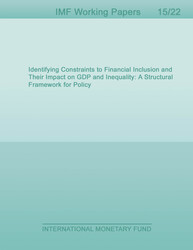
Identifying Constraints to Financial Inclusion and Their Impact on GDP and Inequality : A Structural Framework for Policy
We develop a micro-founded general equilibrium model with heterogeneous agents to identify pertinent constraints to financial inclusion. We evaluate quantitatively the policy impacts of relaxing each of these constraints separately, and in combination, on GDP and inequality. We focus on three dimensions of financial inclusion: access (determined by the size of participation costs), depth (determined by the size of collateral constraints resulting from limited commitment), and intermediation efficiency (determined by the size of interest rate spreads and default possibilities due to costly monitoring). We take the model to a firm-level data from the World Bank Enterprise Survey for six countries at varying degrees of economic development—three low-income countries (Uganda, Kenya, Mozambique), and three emerging market countries (Malaysia, the Philippines, and Egypt). The results suggest that alleviating different financial frictions have a differential impact across countries, with country-specific characteristics playing a central role in determining the linkages and tradeoffs between inclusion, GDP, inequality, and the distribution of gains and losses.
Publication date: January 2015
ISBN: 9781498381598
$18.00
Add to Cart by clicking price of the language and format you'd like to purchase
Available Languages and Formats
| English |
Prices in red indicate formats that are not yet available but are forthcoming.
Topics covered in this book
This title contains information about the following subjects.
Click on a subject if you would like to see other titles with the same subjects.
Financial inclusion , inequality , hetergenous agents , income , credit , gdp , wealth , equilibrium , Financial Markets and the Macroeconomy , Other , Macroeconomic Analyses of Economic Development , Comparative Studies of Countries , hetergenous agents
Summary
Copyright © 2010 - 2024
Powered by:
AIDC



